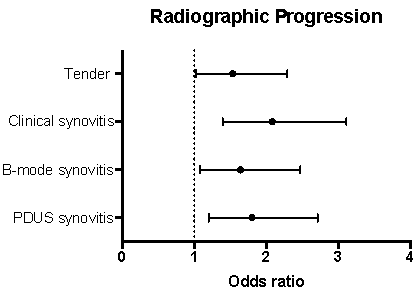Session Information
Title: Rheumatoid Arthritis - Clinical Aspects (ACR): Comorbidities, Treatment Outcomes and Mortality
Session Type: Abstract Submissions (ACR)
Background/Purpose: Longitudinal studies indicate that synovitis can predict subsequent structural damage in rheumatoid arthritis (RA) but the clinical relevance of tenderness is unclear. The aim is to evaluate the predictive validity of tenderness for subsequent structural damage in RA, with synovitis as the comparator.
Methods: Study design: 2-year prospective study. Patients: Active RA (1987 ACR criteria) requiring anti-TNF. Data collected: For each patient, 32 joints were evaluated (2 wrists, 10 MCP, 10 PIP, 10 MTP) for tenderness and clinical synovitis, followed by blinded US assessment for synovitis in B-mode and Power Doppler (PDUS), at baseline and after 4 months of anti-TNF. X-rays of hands and feet were performed at baseline and 2 years. Radiographic progression: occurrence/worsening in structural damage (bone erosion/joint space narrowing) at 2 years compared to baseline. Analysis: The ability of baseline tenderness or synovitis to predict radiographic progression of the same joints at 2 years was compared using odds ratio, OR with 95% confidence interval, through generalized estimating equation adjusted for within patient correlation, age, gender, disease duration, baseline DAS28 and initial structural damage.
Results: Fifty-nine out of the 77 recruited patients had completed the 4 months of the study with radiographic evaluation at 2 years (female: 81%, age 56±12 years, rheumatoid factor positive: 73%). Radiographic progression was observed in 9% of the 1888 evaluated joints (16% of the 118 wrists, 7% of the 590 MCP, 8% of the 590 PIP, and 11% of the 590 MTP). Baseline tender joints were the least predictive for radiographic progression at 2 years (OR=1.53 [1.02; 2.29] p=0.04) when compared to synovitis (clinical OR=2.08 [1.39; 3.11] p<0.001 or PDUS OR=1.80 [1.20; 2.71] p=0.005 respectively) (Figure 1). Tender joints with presence of synovitis, was predictive of radiographic progression (OR=1.89 [1.25, 2.85] p=0.002) while non-tender joints with no synovitis was negatively predictive (OR=0.57 [0.39, 0.82] p=0.003) (Figure 2).
Conclusion: Clinical or US synovitis is more predictive than tenderness to predict subsequent structural progression. Co-existence of tenderness and synovitis at the level of an individual joint would suggest the need for either local/systemic treatment to prevent subsequent structural damage.
Figure 1. The predictive ability of baseline tenderness for radiographic progression at 2 years compared to synovitis
Figure 2. Predictive ability of tenderness with/without synovitis to predict radiographic progression
Disclosure:
P. Cheung,
None;
K. Mari,
None;
V. Devauchelle,
None;
J. Bentin,
None;
S. Jousse-Joulin,
None;
M. A. d’Agostino,
None;
G. Chales,
None;
I. Chary-Valckenaere,
None;
F. Etchepare,
None;
P. Gaudin,
None;
X. Mariette,
None;
A. Saraux,
None;
M. Dougados,
None.
« Back to 2014 ACR/ARHP Annual Meeting
ACR Meeting Abstracts - https://acrabstracts.org/abstract/are-tender-joints-better-than-synovitis-to-predict-structural-damage-in-rheumatoid-arthritis/


